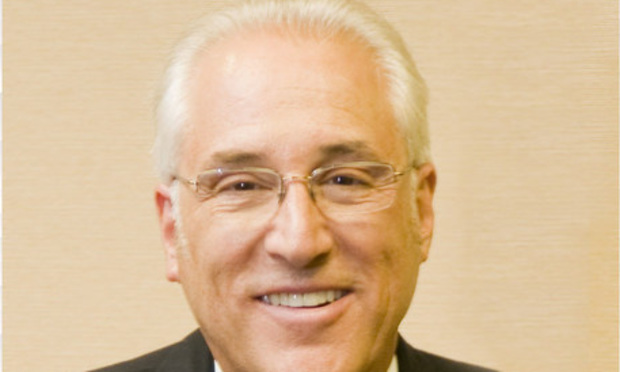New Tax Cuts and Jobs Act Impacts Law Firms and Attorneys: What's in It for You?
Late in December, many local attorneys and law firm administrators were following the Republican tax plan with great anticipation of bringing home fatter paychecks with all that was being negotiated between the House and Senate.
April 19, 2018 at 10:40 AM
5 minute read

Late in December, many local attorneys and law firm administrators were following the Republican tax plan with great anticipation of bringing home fatter paychecks with all that was being negotiated between the House and Senate. A preliminary review by the CPA community tells a different story, and the American Institute of Certified Public Accountants is asking the IRS for immediate guidance with 39 separate areas included in the Tax Cuts and Jobs Act.
Today, most modern law firms are set up in various partnership and corporate structures that essentially let most of a firm's profits flow directly to the equity partners' or shareholders. Common partnership entities include PL, LLLP, PLLC and LP while corporate structures fall into either a C-corporation or subchapter S-corporations. With the exception of engineering and architecture firms, Congress decided not to offer the dramatic tax reductions provided to pass-through service businesses such as law, accounting, health, financial services, brokers, athletes, consulting firms, etc. unless certain maximum taxable income levels are not exceeded.
While some are thinking of converting to a new ownership structure, CPAs, in many cases, explain that the potential double taxation and miscellaneous deduction limitations, remove any incentive to make that change. So what are the benefits and impacts of the new law on attorneys and law firms?
Beginning Sept. 27, 2017, firms purchasing office equipment such as computers, servers, software and furniture will now be able to expense these purchases under Section 179 to a million dollars with an increased phase out threshold of $2.5 million of purchases. The bill also expanded bonus depreciation to allow 100-percent depreciation for qualified property placed in service after Sept. 27, 2017 and before Jan. 1, 2023.
In the area of deductibility of entertainment and meals, there are several major impacts. The bill takes away deductibility for entertainment, or recreation activities, facilities, or membership dues related to such activities and also adds the “directly-related-to” and “associated-with” exceptions to the deduction disallowance. This means reevaluating expenditures such as sports and entertainment tickets and club memberships.
The deduction of meals for entertainment has been changed. The act states that the deductibility for meals consumed near an employer's premises for the convenience of an employer are reduced from 100 to 50 percent. Finally, meals incurred while on business travel are 50 percent deductible. Questions remain as to whether regular business meals are still 50% deductible.
There is a benefit for some shareholders and partners of pass-through entities. There is a new section 199A deduction for taxpayers other than C-corporations to deduct the sum of:
- The lesser of (A) the taxpayer's “combined qualified business income amount” or (B) 20 percent of the excess of the taxpayer's taxable income over capital gain, plus qualified cooperative dividends, plus
- The lesser of (A) 20 percent of the aggregate amount of qualified cooperative dividends or (B) the taxpayer's taxable income (reduced by net capital gains)
This was Congress's way of lessening the tax rate of businesses other than large corporations, but the taxable income limitations will surely impact higher income earners, providing them with no measurable benefit.
There are several other factors for taking this 199A deduction for qualified business income (QBI) for service companies/firms that you should discuss with your tax adviser, but the major exception that will affect high wage earners are the business income deduction exceptions for specified service businesses:
- Where a taxpayer's taxable income does not exceed $315,000 (joint filer) or $157,500 (other filers), subject to full phase-in at $415,000 and $207,500, respectively
- For non-service businesses other than architects and engineers, the deduction attributable to 20 percent of the taxpayer's QBI cannot exceed the greater of (A) 50 percent of W-2 wages paid with respect to the QBI or (B) The sum of 25 percent of W-2 wages plus 2.5 percent of the unadjusted basis of qualified property
- The W-2 wages or W-2 wages plus capital limitation does not apply to taxpayers with taxable income not exceeding $315,000 (joint filers) or $157,500 (other filers). The limitation is phased-in for taxpayers with taxable income exceeding these amounts over ranges of $100,000 and $50,000
As you can see, the legislation is very complex and many areas of the new law are still being ironed out by the IRS. Stay tuned; there is no question things can change based on technical corrections of government officials and the possibility of congressional fixes to the act. Please make sure to consult your tax professional to determine your next steps.
Howard E. Hammer is a principal in the tax planning, compliance and accounting services group at Fiske & Co. in Miami.
This content has been archived. It is available through our partners, LexisNexis® and Bloomberg Law.
To view this content, please continue to their sites.
Not a Lexis Subscriber?
Subscribe Now
Not a Bloomberg Law Subscriber?
Subscribe Now
NOT FOR REPRINT
© 2025 ALM Global, LLC, All Rights Reserved. Request academic re-use from www.copyright.com. All other uses, submit a request to [email protected]. For more information visit Asset & Logo Licensing.
You Might Like
View All
Don’t Forget the Owner’s Manual: A Guide to Proving Liability Through Manufacturers’ Warnings and Instructions
5 minute read


Leveraging the Power of Local Chambers of Commerce: A Second-Career Lawyer’s Guide to Building a Thriving Practice
5 minute readTrending Stories
- 1Decision of the Day: Judge Dismisses Defamation Suit by New York Philharmonic Oboist Accused of Sexual Misconduct
- 2California Court Denies Apple's Motion to Strike Allegations in Gender Bias Class Action
- 3US DOJ Threatens to Prosecute Local Officials Who Don't Aid Immigration Enforcement
- 4Kirkland Is Entering a New Market. Will Its Rates Get a Warm Welcome?
- 5African Law Firm Investigated Over ‘AI-Generated’ Case References
Who Got The Work
J. Brugh Lower of Gibbons has entered an appearance for industrial equipment supplier Devco Corporation in a pending trademark infringement lawsuit. The suit, accusing the defendant of selling knock-off Graco products, was filed Dec. 18 in New Jersey District Court by Rivkin Radler on behalf of Graco Inc. and Graco Minnesota. The case, assigned to U.S. District Judge Zahid N. Quraishi, is 3:24-cv-11294, Graco Inc. et al v. Devco Corporation.
Who Got The Work
Rebecca Maller-Stein and Kent A. Yalowitz of Arnold & Porter Kaye Scholer have entered their appearances for Hanaco Venture Capital and its executives, Lior Prosor and David Frankel, in a pending securities lawsuit. The action, filed on Dec. 24 in New York Southern District Court by Zell, Aron & Co. on behalf of Goldeneye Advisors, accuses the defendants of negligently and fraudulently managing the plaintiff's $1 million investment. The case, assigned to U.S. District Judge Vernon S. Broderick, is 1:24-cv-09918, Goldeneye Advisors, LLC v. Hanaco Venture Capital, Ltd. et al.
Who Got The Work
Attorneys from A&O Shearman has stepped in as defense counsel for Toronto-Dominion Bank and other defendants in a pending securities class action. The suit, filed Dec. 11 in New York Southern District Court by Bleichmar Fonti & Auld, accuses the defendants of concealing the bank's 'pervasive' deficiencies in regards to its compliance with the Bank Secrecy Act and the quality of its anti-money laundering controls. The case, assigned to U.S. District Judge Arun Subramanian, is 1:24-cv-09445, Gonzalez v. The Toronto-Dominion Bank et al.
Who Got The Work
Crown Castle International, a Pennsylvania company providing shared communications infrastructure, has turned to Luke D. Wolf of Gordon Rees Scully Mansukhani to fend off a pending breach-of-contract lawsuit. The court action, filed Nov. 25 in Michigan Eastern District Court by Hooper Hathaway PC on behalf of The Town Residences LLC, accuses Crown Castle of failing to transfer approximately $30,000 in utility payments from T-Mobile in breach of a roof-top lease and assignment agreement. The case, assigned to U.S. District Judge Susan K. Declercq, is 2:24-cv-13131, The Town Residences LLC v. T-Mobile US, Inc. et al.
Who Got The Work
Wilfred P. Coronato and Daniel M. Schwartz of McCarter & English have stepped in as defense counsel to Electrolux Home Products Inc. in a pending product liability lawsuit. The court action, filed Nov. 26 in New York Eastern District Court by Poulos Lopiccolo PC and Nagel Rice LLP on behalf of David Stern, alleges that the defendant's refrigerators’ drawers and shelving repeatedly break and fall apart within months after purchase. The case, assigned to U.S. District Judge Joan M. Azrack, is 2:24-cv-08204, Stern v. Electrolux Home Products, Inc.
Featured Firms
Law Offices of Gary Martin Hays & Associates, P.C.
(470) 294-1674
Law Offices of Mark E. Salomone
(857) 444-6468
Smith & Hassler
(713) 739-1250






